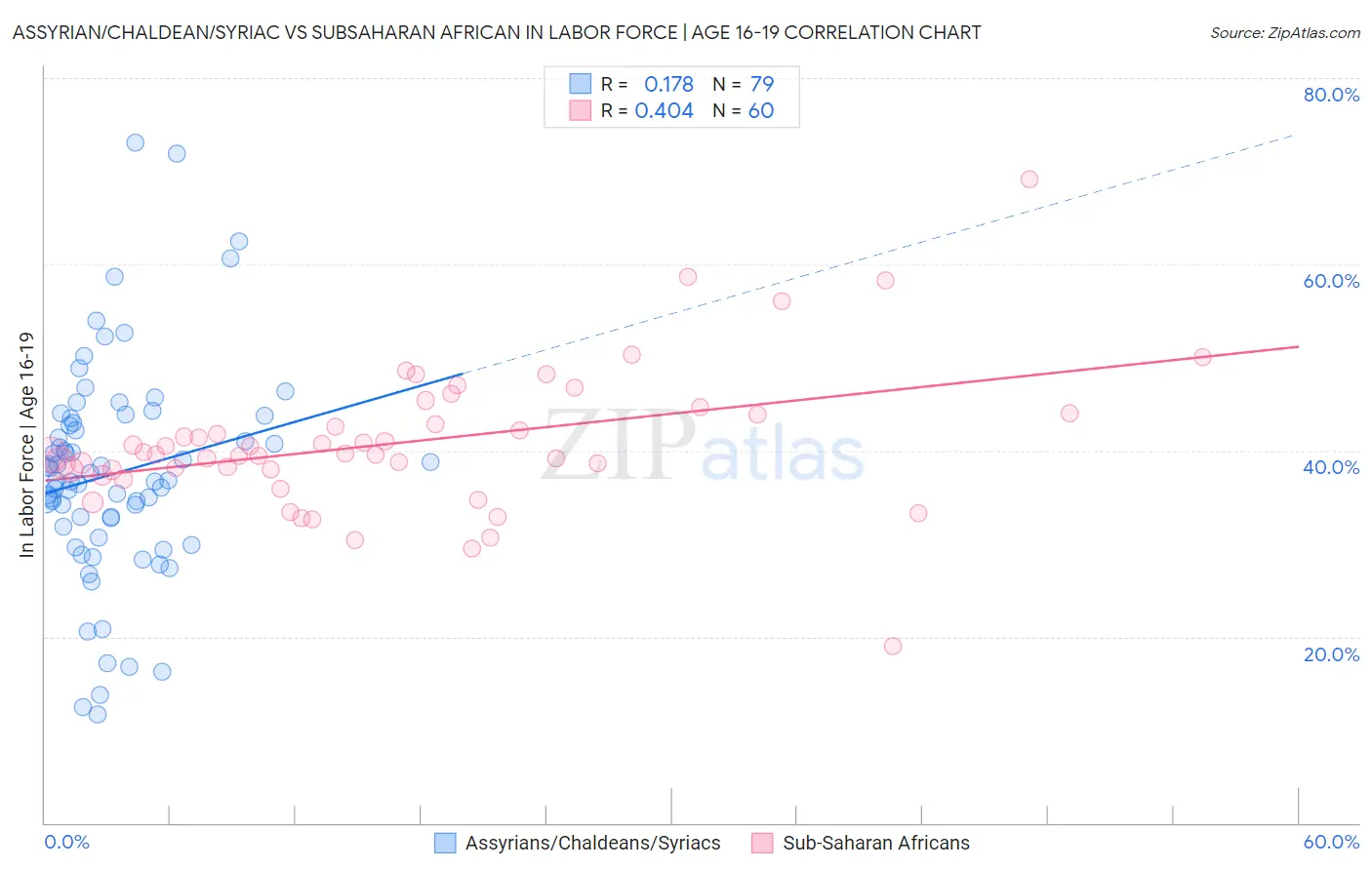Assyrian/Chaldean/Syriac vs Subsaharan African In Labor Force | Age 16-19
COMPARE
Assyrian/Chaldean/Syriac
Subsaharan African
In Labor Force | Age 16-19
In Labor Force | Age 16-19 Comparison
Assyrians/Chaldeans/Syriacs
Sub-Saharan Africans
38.3%
IN LABOR FORCE | AGE 16-19
97.8/ 100
METRIC RATING
119th/ 347
METRIC RANK
38.4%
IN LABOR FORCE | AGE 16-19
98.3/ 100
METRIC RATING
113th/ 347
METRIC RANK
Assyrian/Chaldean/Syriac vs Subsaharan African In Labor Force | Age 16-19 Correlation Chart
The statistical analysis conducted on geographies consisting of 110,301,649 people shows a poor positive correlation between the proportion of Assyrians/Chaldeans/Syriacs and labor force participation rate among population between the ages 16 and 19 in the United States with a correlation coefficient (R) of 0.178 and weighted average of 38.3%. Similarly, the statistical analysis conducted on geographies consisting of 506,892,263 people shows a moderate positive correlation between the proportion of Sub-Saharan Africans and labor force participation rate among population between the ages 16 and 19 in the United States with a correlation coefficient (R) of 0.404 and weighted average of 38.4%, a difference of 0.33%.

In Labor Force | Age 16-19 Correlation Summary
| Measurement | Assyrian/Chaldean/Syriac | Subsaharan African |
| Minimum | 11.7% | 19.0% |
| Maximum | 73.0% | 69.1% |
| Range | 61.3% | 50.1% |
| Mean | 37.5% | 40.9% |
| Median | 36.8% | 39.6% |
| Interquartile 25% (IQ1) | 31.8% | 37.9% |
| Interquartile 75% (IQ3) | 43.5% | 44.0% |
| Interquartile Range (IQR) | 11.7% | 6.0% |
| Standard Deviation (Sample) | 11.6% | 7.7% |
| Standard Deviation (Population) | 11.6% | 7.6% |
Demographics Similar to Assyrians/Chaldeans/Syriacs and Sub-Saharan Africans by In Labor Force | Age 16-19
In terms of in labor force | age 16-19, the demographic groups most similar to Assyrians/Chaldeans/Syriacs are Immigrants from Nepal (38.3%, a difference of 0.020%), Chickasaw (38.3%, a difference of 0.030%), Bulgarian (38.3%, a difference of 0.080%), Colville (38.3%, a difference of 0.080%), and Ukrainian (38.3%, a difference of 0.090%). Similarly, the demographic groups most similar to Sub-Saharan Africans are Hawaiian (38.4%, a difference of 0.10%), Immigrants from Scotland (38.5%, a difference of 0.13%), Crow (38.5%, a difference of 0.14%), Maltese (38.5%, a difference of 0.20%), and Bulgarian (38.3%, a difference of 0.24%).
| Demographics | Rating | Rank | In Labor Force | Age 16-19 |
| Delaware | 98.8 /100 | #106 | Exceptional 38.6% |
| Chinese | 98.8 /100 | #107 | Exceptional 38.6% |
| Immigrants | Ethiopia | 98.7 /100 | #108 | Exceptional 38.6% |
| Lebanese | 98.7 /100 | #109 | Exceptional 38.6% |
| Maltese | 98.6 /100 | #110 | Exceptional 38.5% |
| Crow | 98.5 /100 | #111 | Exceptional 38.5% |
| Immigrants | Scotland | 98.5 /100 | #112 | Exceptional 38.5% |
| Sub-Saharan Africans | 98.3 /100 | #113 | Exceptional 38.4% |
| Hawaiians | 98.2 /100 | #114 | Exceptional 38.4% |
| Bulgarians | 97.9 /100 | #115 | Exceptional 38.3% |
| Colville | 97.9 /100 | #116 | Exceptional 38.3% |
| Chickasaw | 97.8 /100 | #117 | Exceptional 38.3% |
| Immigrants | Nepal | 97.8 /100 | #118 | Exceptional 38.3% |
| Assyrians/Chaldeans/Syriacs | 97.8 /100 | #119 | Exceptional 38.3% |
| Ukrainians | 97.6 /100 | #120 | Exceptional 38.3% |
| Ethiopians | 97.4 /100 | #121 | Exceptional 38.2% |
| Guamanians/Chamorros | 97.4 /100 | #122 | Exceptional 38.2% |
| Seminole | 96.7 /100 | #123 | Exceptional 38.1% |
| Immigrants | England | 96.4 /100 | #124 | Exceptional 38.1% |
| Immigrants | Africa | 96.1 /100 | #125 | Exceptional 38.0% |
| Africans | 95.6 /100 | #126 | Exceptional 38.0% |